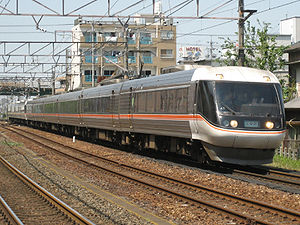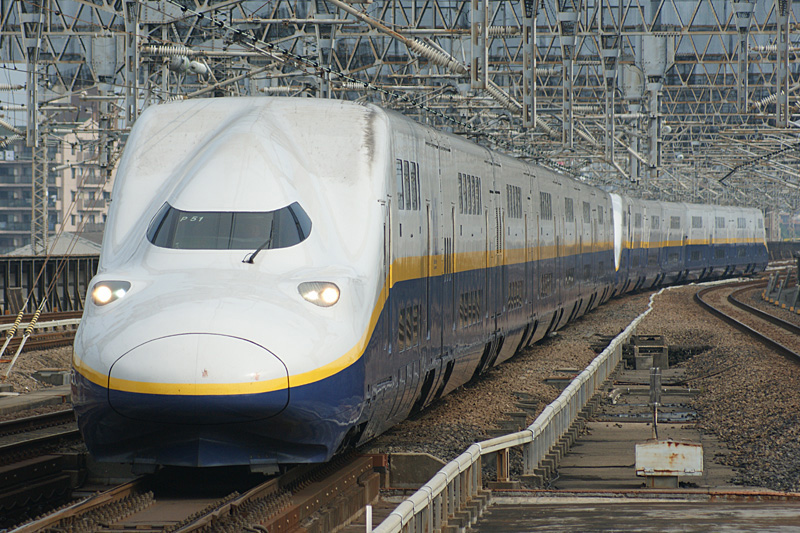Page 13 of 29
Re: Trens i infraestructura ferroviària al Japó
Posted: Monday 14/03/2011 10:00
by Nozomi
Re: Trens i infraestructura ferroviària al Japó
Posted: Tuesday 15/03/2011 10:21
by Nozomi
Terremoto en Japón - incidencias ferroviarias
Daños en la estructura del Tohoku Shinkansen (Tokio - Shin-Aomori)
* Catenary severed at ~200 locations
* Catenary masts bent at ~250 locations
* Columns supporting aerial structures damaged at ~90 locations
* Track damaged at ~20 locations
* Ceilings fell at 5 stations including Sendai
* Bridge girder displacement at 2 locations
* No aerial structure or tunnel collapses
http://www.asahi.com/special/10005/TKY201103140522.html
Daños en la estación de Sendai. Vídeo de TBS 14 de marzo.
Re: Trens i infraestructura ferroviària al Japó
Posted: Tuesday 15/03/2011 10:34
by Nozomi
Re: Trens i infraestructura ferroviària al Japó
Posted: Wednesday 23/03/2011 9:59
by Nozomi
Re: Trens i infraestructura ferroviària al Japó
Posted: Sunday 27/03/2011 17:21
by Nozomi
Re: Trens i infraestructura ferroviària al Japó
Posted: Sunday 27/03/2011 17:23
by PoLeTe124
Quin tren més impressionant! Sobretot la part del tester de cabina. Aquest és un tren nou d'Alta Velocitat o és per convencional?
Re: Trens i infraestructura ferroviària al Japó
Posted: Sunday 27/03/2011 17:37
by Nozomi
No no, esto son trenes para líneas convencionales. Velocidad máxima de 130 km/h.
El nuevo tren de la serie EMU 287 "Konotori" reemplaza a los trenes de la serie 183, servicios "Kinosaki" y "Kitakinki".


Eso no significa que estos trenes de los años 70 dejen de circular. Lo harán en esos servicios, pero no en otros servicios

.
Re: Trens i infraestructura ferroviària al Japó
Posted: Sunday 27/03/2011 17:39
by PoLeTe124
Doncs aquests trens, per ser dels anys 70, tenen un bon disseny digne de farà pocs anys!! I encara no em crec què siguin per via convencional, amb aquest disseny.. Se'm fa estrany!
Re: Trens i infraestructura ferroviària al Japó
Posted: Sunday 27/03/2011 20:33
by wefer
Nozomi wrote:No no, esto son trenes para líneas convencionales. Velocidad máxima de 130 km/h.
I suposo que via mètrica, oi?
Vaja, l'equivalent de les 213 d'aquí. Igualets, igualets

El que més em sobta és aquest frontal tant blanc, i més per part dels japonesos que tenen tendència a fer uns grafismes recarregats de colors, formes i textos.
Per cert: quines distàncies cobreixen aquests trens?
Re: Trens i infraestructura ferroviària al Japó
Posted: Sunday 27/03/2011 21:32
by Nozomi
Sí, todo en vía métrica. Los trenes Limited Express son la versión local de nuestros trenes de Larga Distancia. Por ejemplo, podríamos ir de Tokio a Sendai con el tren bala y con el Ltd. Express, aunque te podrías morir, está pensado para las poblaciones intermedias en casos en los que se solapa con las líneas del Shinkansen.
Las distancias, pues aquí van algunas:
Super Azusa (JR EAST): Shinjuku - Matsumoto - 225km

Super Hitachi (JR EAST): Ueno - Sendai - 363km

Shinano (JR CENTRAL): Nagoya - Nagano - 211km

Fujikawa (JR CENTRAL): Shizuoka - Kofu - 122km

Konotori (JR WEST): Shin Osaka - Kinosaki onsen - 187km

Hamakaze (JR WEST): Osaka - Tottori - 211km

Super Hokuto (JR HOKKAIDO): Sapporo - Hakodate - 319km

Shiokaze (JR SHIKOKU): Okayama - Uwajima - 311km

Kamome (JR KYUSHU): Hakata - Nagasaki - 154km

Re: Trens i infraestructura ferroviària al Japó
Posted: Friday 01/04/2011 11:41
by Nozomi
Fukushima
Posted: Friday 01/04/2011 12:00
by Guigui
El perímetre d'exclusió al voltant de la central nuclear de Fukushima afecta el trànsit ferroviari?
Re: Trens i infraestructura ferroviària al Japó
Posted: Friday 01/04/2011 12:29
by Nozomi
Pues lo afectará en la línea costera (rojo grueso), es decir la Joban Line (Tokio - Sendai) y en la Ban'etsu East Line (Koriyama - Iwaki) en la zona de exclusión, que es desde Funehiki (a unos 10 km de Koriyama).
De momento el perímetro de exclusión no afectaría al Shinkansen.
Re: Trens i infraestructura ferroviària al Japó
Posted: Wednesday 20/04/2011 11:07
by Nozomi
Re: Trens i infraestructura ferroviària al Japó
Posted: Wednesday 20/04/2011 11:10
by Nozomi
En otro orden de cosas... una mala noticia, quieren retirar en unos años todas las unidades de trenes de dos pisos tipo MAX, trenes de la serie E1 y E4. Es un poco raro que se los vayan a cargar tan pronto. De hecho, los construyeron para mejorar la capacidad en la línea para servicios tipo "cercanías". El E4 (MAX Yamabiko) circula entre Tokio y Sendai y el E1 y E4 (MAX Toki y MAX Tanigawa) entre Tokio y Niigata, especialmente preparado para llevar en tren bala a la gente que quiere ir a las pistas de esquí de los Alpes centrales. ¿Problema de estos trenes? Sólo alcanzan los 240 kph de velocidad máxima. En una línea prevista en un futuro para ir a 320 (series E5 y E6). Otra cosa es que ya estén desarrollando un nuevo tren de dos pisos para ir a 300.
Double-decked bullet trains to be scrapped in 5 years
Double-decked bullet trains will be decommissioned in five years from the Tohoku and Joetsu Shinkansen lines, their operator said.
The aging Series E-1 and E-4 trains will retire with the introduction of the most advanced Series E-5 trains capable of traveling at 320 kilometers per hour.
Double-decked E-1 and E-4 trains are called Multi-Amenity Express (MAX) trains. East Japan Railway Co. (JR East) introduced the first 12-car E-1 train for its Joetsu Shinkansen Line in July 1994.
Since all carriages are double-decked, the number of the seating capacity per coach was about 40 percent more than ordinary bullet trains that the company operates. Three seats are installed on both sides of the isle on the upper deck. This has helped ease congestion during rush hours and holiday periods.
Each carriage has an elevator for wheelchairs and a certain space on the upper deck is set aside for passengers in wheelchairs. Moreover, E-1 trains have baby beds and powder rooms.
In particular, seats on the upper decks have enjoyed high popularity with passengers because they command fine views. Currently, six E-1 trains, totaling 72 cars, are operated on the Joetsu Shinkansen Line between Tokyo and Niigata.
Eight-car E-4 trains, whose front cars have longer noses than those of the E-1 to prevent them from creating excessive noise when they enter tunnels, made their debut in December 1997. Two eight-car trains can be linked into a 16-carriage train with a total seating capacity of 1,634, the highest in the world.
Twenty-six E-4 trains, totaling 208 coaches, are operated mainly on the Tokyo-Sendai section of the Tohoku Shinkansen Line.
The service life of bullet trains was initially believed to be about 15 years, but it has been extended by about 10 years because of advancements in maintenance technology.
Seventeen years have passed since the first E-1 train was introduced and 14 years since the introduction of the E-4.
However, some passengers have complained to JR East that the upper deck seats cannot be turned around and others call for the expansion of upper deck isles, while others have pointed out that the boarding positions for MAX trains are different from those for other trains and are confusing.
JR East is scheduled to begin decommissioning older E-1 trains in July next year and put all MAX trains out of service in five years.
E4

E1

Re: Trens i infraestructura ferroviària al Japó
Posted: Monday 25/04/2011 18:32
by jaezcurra
http://www.elperiodico.cat/ca/noticias/ ... nar-983829
MES I MIG D'ATURADA
El tren bala entre Tòquio i Sendai torna a funcionar després del tsunami
S'espera que la restitució de l'alta velocitat ajudi a accelerar la reconstrucció i la recuperació econòmica
Dilluns, 25 de abril del 2011 - 11:44h. EFE / Tòquio
El tren bala japonès (Shinkansen) entre Tòquio i Sendai, ciutat que va resultar molt afectada pel tsunami, ha tornat a funcionar aquest dilluns per primera vegada des de la catàstrofe de l'11 de març, segons ha informat l'agència Kyodo.
La recuperació del servei després de gairebé mes i mig d'aturada es deu al fet que aquest dilluns s'ha restablert el tram entre la ciutat de Fukushima i Sendai, capital de Miyagi, província en què el desastre ha deixat 8.669 morts i 6.856 desapareguts, segons l'últim recompte policial.
S'espera que la restitució de l'alta velocitat entre Tòquio i Sendai, uns 200 quilòmetres al nord de la capital nipona, ajudi a accelerar la reconstrucció i a potenciar el turisme a la regió de Tohoku, la més afectada pel tsunami.
Una altra línia es restablirà
La companyia operadora, JR East, ha dit que divendres, 29 d'abril, tornarà també a funcionar tot el traçat d'aquesta línia de Shinkansen, que uneix Tòquio i la ciutat d'Aomori, a l'extrem nord de l'illa de Honshu.
Les línies aèries japoneses JAL i ANA van anunciar la setmana passada que les reserves per viatjar a aquesta zona del nord-est japonès durant la Golden Week (setmana daurada), que arrenca el 29 d'abril, van augmentar fins a tal punt que entre totes dues planegen disposar 450 vols extra.
L'aeroport de la ciutat de Sendai, que va ser cobert per l'onada gegant l'11 de març, va començar a funcionar parcialment el 13 d'abril amb connexions amb Tòquio i Osaka, mentre que el port va reobrir al trànsit comercial el 16 d'abril.
El terratrèmol i el tsunami de l'11 de març van paralitzar línies ferroviàries al nord del país, van destruir infraestructures bàsiques i van deixar 14.340 morts i 11.889 desapareguts, segons les últimes dades de la policia japonesa.
Re: Trens i infraestructura ferroviària al Japó
Posted: Monday 25/04/2011 18:55
by Nozomi
Excelente noticia, será curioso ver la respuesta de muchos japoneses de cara a la Golden Week, tal vez animen la economía local pasando sus vacaciones en las regiones de Iwate o Miyagi.
Noticia de hoy en ANN sobre la reapertura de los servicios de alta velocidad entre Tokio y Sendai. Estación de Sendai.
Re: Trens i infraestructura ferroviària al Japó
Posted: Saturday 30/04/2011 13:11
by Nozomi
Re: Trens i infraestructura ferroviària al Japó
Posted: Saturday 30/04/2011 15:57
by Lluita1714
Quina capacitat d'aixecar-se ràpidament! Aquí potser haguéssim estat tres anys per reconstruir la xarxa.
























































